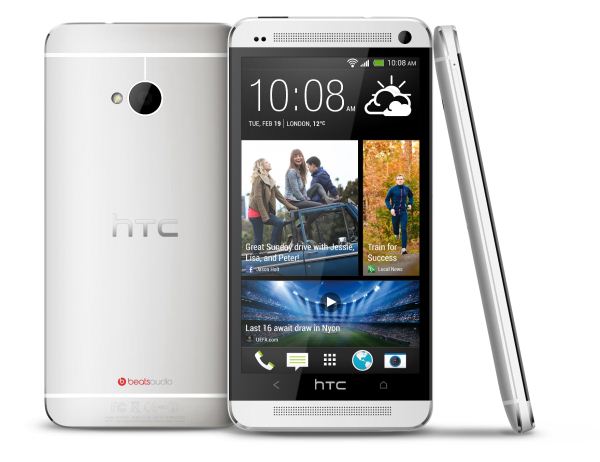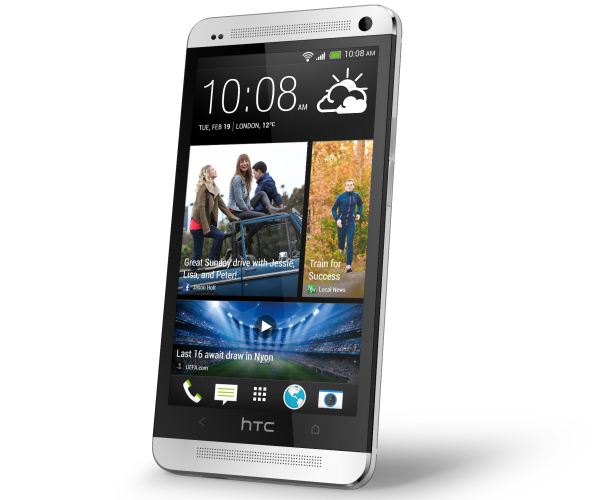Hands on and Impressions from the HTC One - Formerly M7
by Brian Klug on February 19, 2013 10:30 AM EST- Posted in
- Smartphones
- HTC
- Mobile
- HTC One
- Snapdragon 600
HTC is in an interesting position as a result of this last product cycle. While the previous HTC One series’ industrial design and performance was top notch, other OEMs still managed to eclipse the One series in terms of market adoption and consumer perception. Getting back to being a solid performer and cementing a place as at least the dominant number three player in the smartphone space is HTC’s mission for 2013, and the flagship device it’s starting that out with is the device previously known as M7, now known simply as the HTC One.
Design and Construction
The choice of the HTC One name really emphasizes how much this launch means to HTC — this is the canonical One. This is the fullest expression of HTC’s view for what the One lineup should mean, this is their flagship. The One is a clear evolution of the industrial design first begun with the Butterfly and DNA, except instead of plastic the One is machined from a single solid block of aluminum. There are over 200 minutes of CNC machine cuts per device, which is a unibody construction. Plastic is injected into the aluminum block after certain cuts are made for the back case, which then gets machined into the final form. The One uses the top and bottom aluminum strips for antennas, both of which are actively tuned to mitigate unintended attenuation from being held. There’s a plastic insulative strip in-between the two antennas and the main body. In spite of being aluminum, the One also includes NFC, whose active area surrounds the camera region. There’s no wireless charging from Qi or WPC, however.
In the hands the HTC One has the kind of fit and finish that I’d expect from a high end device. I thought that the One S was perhaps the best industrial design of 2012 in part thanks to the metal backside, unique concave shape, and size. The truth is that the HTC One feels even better than that. There’s something inescapable about metal — HTC described it as expensive and luxurious feeling, like a well crafted tool. Other OEMs with metal phones like to evoke imagery of watches or high end jewelry. I think at some fundamental level metal does imply value, and as a result it conveys a much higher end in-hand feel than other entirely polycarbonate plastic designs. There’s a thin strip of plastic which runs around the edge of the device, and it’s here that the microSIM tray, ejection port, primary microphone, microUSB port, power/lock button (which doubles as IR transmit and receive), earphone jack, and volume rocker sit. The front has two aluminum pieces which serve as the speaker, microphone, and earpiece grilles. The HTC One will come in both an uncolored silver version, and anodized black.
The One is topped with a 4.7-inch 1080p Super LCD 3 display. We’ve said that 2013 is going to be the year of 5-inch phones, and 4.7 is just shy. I think there’s something almost optimal about the device size that results with a 16:9 display size just short of 5-inches diagonal. It’s still possible to one hand if you have medium sized hands, easy to pocket, and still not laughably huge.
The HTC One at first glance might seem reminescent of another big metal unibody device, but in the hand couldn’t feel any more different. The convex rounded back side gives the One an entirely different in-hand feel, and the edges have a slight negative angle to them in addition to two chamfers.
Rather than place the primary speaker on the backside of the One, HTC has placed a set of speakers on the front of the device, one at top, one at bottom, behind the two grilles. These two provide stereo sound, and placing them on the front instead of the bottom or back makes a lot of sense for things like watching video, Google Navigation, and listening to music. The One also has dual microphones for noise rejection on calls, and also two different microphone pairs for accommodating low volume and high volume environments when recording audio. For example the commodity microphones generally included in a smartphone saturate around 70 dBA, HTC claims the dual microphone system on the One can accommodate up to 120 dBA SPL (Sound Pressure Level) without saturating.


















139 Comments
View All Comments
groundhogdaze - Wednesday, February 20, 2013 - link
I don't always need extra space but when I do, I prefer removable micro-SD. If it comes down to choosing HTC or a Samsung phone which comes with a SD slot, guess which phone folks will buy? Wrong move HTC.khanov - Thursday, February 21, 2013 - link
Perhaps bah has never been on holiday overseas and thus doesn't understand why SD card slots are so useful.Take your phone/camera overseas, shoot a bunch of snaps and some video and fill up your internal memory within a day or two. Then tell us no one cares about SD cards.
But hey you could use the cloud to offload your crap and free up the internal memory? Yeah right, would only cost like $1000 in global roaming charges.
g0d5hand - Tuesday, February 26, 2013 - link
This a hundred times! And holding movies and comic books and media in general. It seems some people are so against having a sd slot. why? if you like cloud service that is cool, to me it just seems like another way to get money from me. I like the idea of having my media available when offline in any scenario, like long train rides and flights.the sd card issue got me to wait for a few months to get the s3 over the one x.
Bayusuputra - Thursday, April 4, 2013 - link
It supports USB on the go FYI, and isn't that as practical, or even more practical, than popping in/out MicroSD cards? And basically people with computers use thumbdrives more often than microSD cards, so that could add another point for practicality. :)will2 - Tuesday, February 19, 2013 - link
And another !! Seriously, I read in many articles the reason why 'See no evil' Google deliberately cripples their Nexus phone in a small way, like lack of expandable memory, is to avoid upsetting other makers of Android phones too much, and why other makers omit SD slot is to force buyers into early decision into how much storage they might need over life of the phone.Lack of SD was the only serious flaw in the Nexus 7, and stopped me buying it.
will2 - Tuesday, February 19, 2013 - link
Meant to add, reason for 'other makers' forcing buyers into early decision on how much storage they might need... is to make more money., as users can buy SD storage far cheaper than from the phone makerbernstein - Tuesday, February 19, 2013 - link
it's not so much the missing sd card slot, but the GB that count... and an SD slot counts for +64gb. it also rises the price by $60. that's the basis for phone comparison...for me 32gb has become the absolute minimum so any phone locked to less is just out (well with the exception of the nexus devices, for obvious reasons)...
darwinosx - Wednesday, February 20, 2013 - link
That's not why. Google knows SD cards are a pain and doesn't want to support them. It not just on the Nexus hardware its in Jelly Bean.usopen65667268 - Tuesday, February 19, 2013 - link
Totally disagree with you on this one. SD cards are a nice option to have considering the amount of storage space needed to store high definition movies, 1080p video recordings, photos, and games that require buckets and buckets of megabytes. I will say however this was a nice decision made on HTC's part to finally ship a flagship phone starting with 32GB's and giving customers the option to expand that to 64GB if so desired.I think one of the major differences between Samsung and HTC when talking about their respective flagship phones is storage space. When you compare devices side by side they both deliver quite nicely on almost all fronts. But the one glaring omission on HTC flagship devices is the disappointing lack of storage. HTC ONE X shipped with 16GB and no SD card and so did the DNA which I own.
I thought long and hard about the DNA because of that very reason and almost went with Samsung, and I am a huge HTC fan. The only reason I thought I could get away with this omission was because of Verizon's Network. I am glad I bought the DNA and love the phone to death, but if I am being honest, I will never buy another phone with only 16GB of storage, period!
darwinosx - Wednesday, February 20, 2013 - link
Of course the DNA only has 11 GB of usable storage out of that 16.